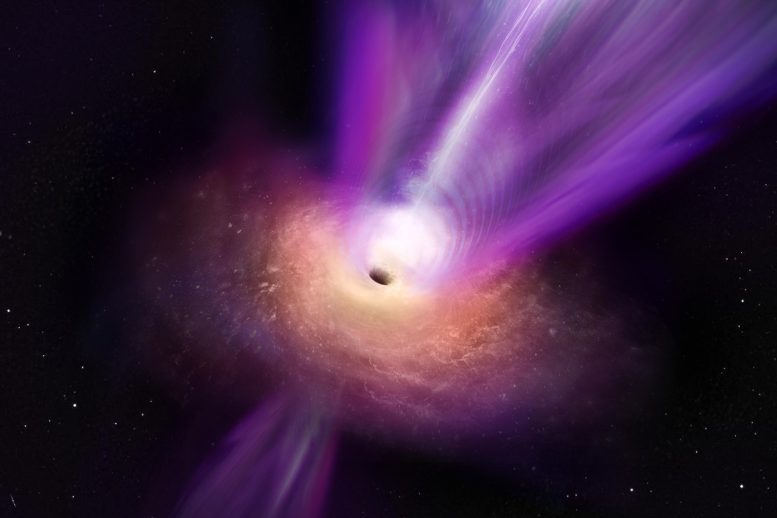
Scientists observing the compact radio core of M87 have discovered new details about the galaxy’s supermassive black hole. In this artist’s conception, the black hole’s massive jet is seen rising up from the center of the black hole. The observations on which this illustration is based represent the first time that the jet and the black hole shadow have been imaged together, giving scientists new insights into how black holes can launch these powerful jets. Credit: S. Dagnello (NRAO/AUI/NSF)
The observations will help astronomers pin down the physics of the plasma around black holes.
Astronomers have used the Global Millimeter VLBI Array (GMVA) to capture detailed images of M87*, revealing a larger, intense plasma ring and visual evidence of the black hole’s accretion disk and relativistic jet. These insights could pave the way for a better understanding of black hole physics.
In 2017, astronomers captured the first image of a black hole by coordinating radio dishes around the world to act as a single, planet-sized telescope. The synchronized network, known collectively as the Event Horizon Telescope (EHT), focused in on M87*, the black hole at the center of the nearby Messier 87 galaxy. The telescope’s laser-focused resolution revealed a very thin glowing ring around a dark center, representing the first visual of a black hole’s shadow.
Astronomers have now refocused their view to capture a new layer of M87*. The team, including scientists at MIT’s Haystack Observatory, has harnessed another global web of observatories — the Global Millimeter VLBI Array (GMVA) — to capture a more zoomed-out view of the black hole.
The new images, taken one year after the EHT’s initial observations, reveal a thicker, fluffier ring that is 50 percent larger than the ring that was first reported. This larger ring is a reflection of the telescope array’s resolution, which was tuned to pick up more of the super-hot, glowing plasma surrounding the black hole.
For the first time, scientists could see that part of the black hole’s ring consists of plasma from a surrounding accretion disk — a swirling pancake of white-hot electrons that the team estimates is being heated to billions of degrees Celsius as the plasma streams into the black hole at close to the speed of light.
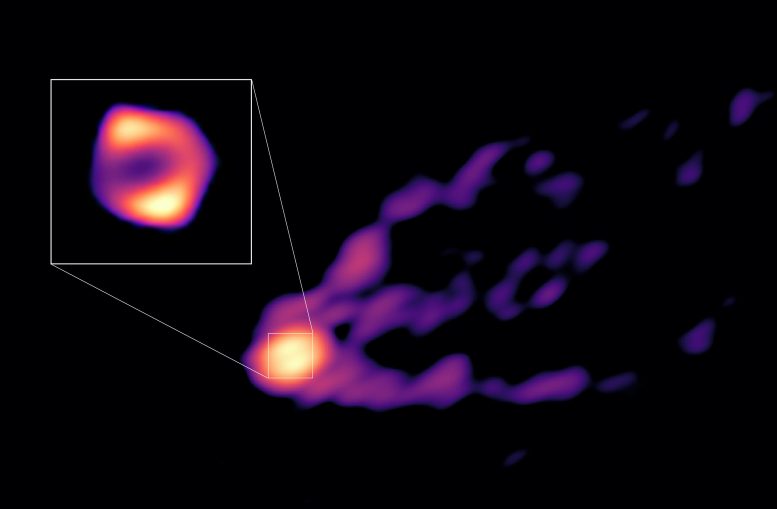
This image shows the jet and shadow of the black hole at the centre of the M87 galaxy together for the first time. The observations were obtained with telescopes from the Global Millimetre VLBI Array (GMVA), the Atacama Large Millimeter/submillimeter Array (ALMA), of which ESO is a partner, and the Greenland Telescope. This image gives scientists the context needed to understand how the powerful jet is formed. The new observations also revealed that the black hole’s ring, shown here in the inset, is 50% larger than the ring observed at shorter radio wavelengths by the Event Horizon Telescope (EHT). This suggests that in the new image we see more of the material that is falling towards the black hole than what we could see with the EHT. Credit: R.-S. Lu (SHAO), E. Ros (MPIfR), S. Dagnello (NRAO/AUI/NSF)
The images also reveal plasma trailing out from the central ring, which scientists believe to be part of a relativistic jet blasting out from the black hole. The scientists tracked these emissions back toward the black hole and observed for the first time that the base of the jet appears to connect to the central ring.
“This is the first image where we are able to pin down where the ring is, relative to the powerful jet escaping out of the central black hole,” says Kazunori Akiyama, a research scientist at MIT’s Haystack Observatory, who developed the imaging software used to visualize the black hole. “Now we can start to address questions such as how matter is captured by a black hole, and how it sometimes manages to escape.”
Akiyama is part of an international team of astronomers who present the new images, along with their analysis, in a paper published on April 26 in the journal Nature.
An expanded eye
To capture images of M87*, astronomers used a technique in radio astronomy known as very-long-baseline interferometry, or VLBI. When a radio signal passes by Earth, such as from a black hole’s plasma emissions, radio dishes around the world can pick up the signal. Scientists can then determine the time at which each dish registers the signal, and the distance between dishes, and combine this information in a way that is analogous to the signal being seen by one very large, planet-scale telescope.
When each radio telescope is dialed to a specific frequency, the array as a whole can focus in on a particular feature of the radio signal. The EHT’s network was tuned to 1.3 millimeters — a resolution equivalent to seeing a grain of rice in California, from Massachusetts. At this resolution, astronomers could see past most of the plasma surrounding M87* and image the thinnest ring, thereby accentuating the black hole’s shadow.
In contrast, the GMVA network works at a slightly longer wavelength of 3 millimeters, giving it a slightly lower angular resolution. With this focus, the array could resolve a pumpkin seed, rather than a grain of rice. The network itself consists of about a dozen radio telescopes scattered around the United States and Europe, mostly located along the east-west axis of the Earth. To make a truly planet-sized telescope able to capture a far-off radio signal from M87*, astronomers had to expand the array’s “eye” to the north and south.
To do so, the team involved two additional radio observatories: the Greenland Telescope to the north, and the Atacama Large Millimeter/submillimeter Array (ALMA) to the south. ALMA is an array of 66 radio dishes located in Chile’s Atacama Desert. MIT Haystack scientists, including Principal Research Scientist Lynn Matthews, worked to phase, or synchronize, ALMA’s dishes to work as one powerful and essential part of the GMVA network.
“Having these two telescopes [as part of] the global array resulted in a
boost in angular resolution by a factor of four in the north-south direction,” Matthews says. “This greatly improves the level of detail we can see. And in this case, a consequence was a dramatic leap in our understanding of the physics operating near the black hole at the center of the M87 galaxy.”
Tuning in
On April 14 and 15 of 2018, astronomers coordinated the telescopes of the GMVA, along with the Greenland and ALMA observatories, to record radio emissions at a wavelength of 3 millimeters, arriving from the direction of the M87 galaxy. Scientists then used several imaging-processing algorithms, including one developed by Akiyama, to process the GMVA’s observations into visual images.
The resulting pictures reveal more plasma surrounding the black hole, in the form of a larger, fluffier ring. The astronomers could also spot plasma trailing up and out from the central glowing ring.
“The exciting thing is, we still see a central dark area enclosing the black hole, but we also start to see a more extended jet, stemming from this central ring,” Akiyama says.
The astronomers hope to pin down more properties of the black hole’s plasma, such as its temperature profile and composition. For this, they plan to tune the EHT and GMVA to new resolutions. By observing M87* at multiple wavelengths, they can then construct a layered picture, and a more detailed understanding of black holes and the jets they generate.
“If something major happens in the world, you might tune in to both AM and FM to assemble a ‘complete picture’ of the event,” says Geoffrey Crew, a Haystack research scientist who works to support ALMA and the EHT. “This is no different. You might think of the EHT M87* image being made in FM, and this result coming from AM. Both tell a story, and together it is a better story.”
For more on this discovery, see Historic First Direct Image of a Black Hole Emitting a Powerful Jet.
Reference: “A ring-like accretion structure in M87 connecting its black hole and jet” by Ru-Sen Lu, Keiichi Asada, Thomas P. Krichbaum, Jongho Park, Fumie Tazaki, Hung-Yi Pu, Masanori Nakamura, Andrei Lobanov, Kazuhiro Hada, Kazunori Akiyama, Jae-Young Kim, Ivan Marti-Vidal, José L. Gómez, Tomohisa Kawashima, Feng Yuan, Eduardo Ros, Walter Alef, Silke Britzen, Michael Bremer, Avery E. Broderick, Akihiro Doi, Gabriele Giovannini, Marcello Giroletti, Paul T. P. Ho, Mareki Honma, David H. Hughes, Makoto Inoue, Wu Jiang, Motoki Kino, Shoko Koyama, Michael Lindqvist, Jun Liu, Alan P. Marscher, Satoki Matsushita, Hiroshi Nagai, Helge Rottmann, Tuomas Savolainen, Karl-Friedrich Schuster, Zhi-Qiang Shen, Pablo de Vicente, R. Craig Walker, Hai Yang, J. Anton Zensus, Juan Carlos Algaba, Alexander Allardi, Uwe Bach, Ryan Berthold, Dan Bintley, Do-Young Byun, Carolina Casadio, Shu-Hao Chang, Chih-Cheng Chang, Song-Chu Chang, Chung-Chen Chen, Ming-Tang Chen, Ryan Chilson, Tim C. Chuter, John Conway, Geoffrey B. Crew, Jessica T. Dempsey, Sven Dornbusch, Aaron Faber, Per Friberg, Javier González García, Miguel Gómez Garrido, Chih-Chiang Han, Kuo-Chang Han, Yutaka Hasegawa, Ruben Herrero-Illana, Yau-De Huang, Chih-Wei L. Huang, Violette Impellizzeri, Homin Jiang, Hao Jinchi, Taehyun Jung, Juha Kallunki, Petri Kirves, Kimihiro Kimura, Jun Yi Koay, Patrick M. Koch, Carsten Kramer, Alex Kraus, Derek Kubo, Cheng-Yu Kuo, Chao-Te Li, Lupin Chun-Che Lin, Ching-Tang Liu, Kuan-Yu Liu, Wen-Ping Lo, Li-Ming Lu, Nicholas MacDonald, Pierre Martin-Cocher, Hugo Messias, Zheng Meyer-Zhao, Anthony Minter, Dhanya G. Nair, Hiroaki Nishioka, Timothy J. Norton, George Nystrom, Hideo Ogawa, Peter Oshiro, Nimesh A. Patel, Ue-Li Pen, Yurii Pidopryhora, Nicolas Pradel, Philippe A. Raffin, Ramprasad Rao, Ignacio Ruiz, Salvador Sanchez, Paul Shaw, William Snow, T. K. Sridharan, Ranjani Srinivasan, Belén Tercero, Pablo Torne, Efthalia Traianou, Jan Wagner, Craig Walther, Ta-Shun Wei, Jun Yang and Chen-Yu Yu, 26 April 2023, Nature.
DOI: 10.1038/s41586-023-05843-w


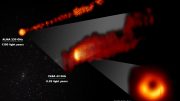
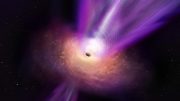

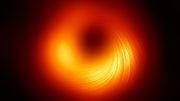
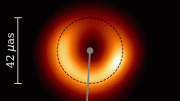
hey, glorious blog on suety loss. corresponding helped.